
Ching-Te is a small lunar impact crater located in a mountainous area to the east of the Mare Serenitatis. It is a circular, bowl-shaped formation with no distinguishing features.
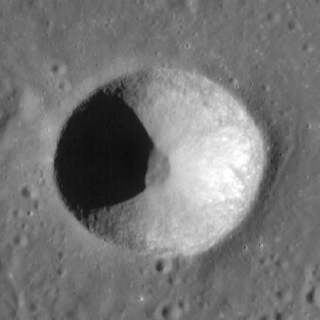
Biot is a small, bowl-shaped lunar impact crater located in the southern reaches of the Mare Fecunditatis. It is named after French astronomer Jean-Baptiste Biot."Biot (crater)". Gazetteer of Planetary Nomenclature. USGS Astrogeology Research Program. It is a circular formation with a sharp-edged rim that has not been significantly worn. The inner walls slope down to a relatively small interior floor. The albedo of the wide inner walls is higher than the surrounding lunar mare, giving it a light hue. To the southeast is the crater Wrottesley.

Abbot is a small lunar impact crater that lies on the rugged ground between the Mare Fecunditatis in the south and west, and the Mare Crisium to the north. It is a circular crater with a cup-shaped interior. The inner walls slope downward to the midpoint, and no impacts of significant mark the interior or the rim.

Beketov is a small lunar impact crater that lies in the northern reaches of the Mare Tranquillitatis. It is named after Russian chemist Nikolay Beketov. To the south is the ghost crater Jansen R. Northeast of Beketov, along the edge of the mare, is the crater Vitruvius. Beketov was previously designated Jansen C before being named by the IAU. The flooded crater Jansen itself lies to the south.

Cavalerius is a prominent lunar impact crater that lies on the western edge of the Oceanus Procellarum lunar mare on the west part of the visible Moon. It nearly joins the northern rim of Hevelius to the south.

Vitruvius is a small lunar impact crater that lies on the northern edge of the Mare Tranquillitatis. To the east is the crater Gardner, and to the northeast is Fabbroni. To the north-northwest is the elongated Mons Vitruvius mountain, and beyond is the valley where the Apollo 17 mission landed.

Archytas is a lunar impact crater that protrudes into the northern edge of Mare Frigoris. To the northwest is the comparably sized crater Timaeus, and the smaller Protagoras lies in the opposite direction to the southeast. Further to the southwest, beyond the opposite edge of the mare, is the dark-floored crater Plato.
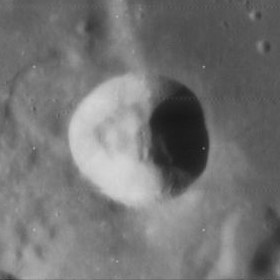
Bellot is a small lunar impact crater that is located on the southwest edge of Mare Fecunditatis. It lies between the craters Goclenius to the northwest and Crozier to the southeast. To the southwest is Colombo, and to the west is Magelhaens.
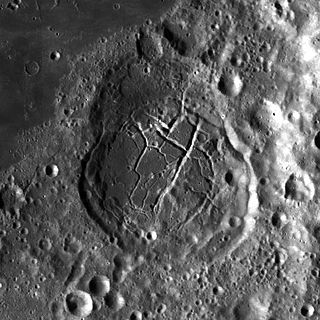
Komarov is a lunar impact crater that lies across the southeastern edge of Mare Moscoviense, on the northern hemisphere of the far side of the Moon. It is a complex feature with an irregular appearance.

Black is a small lunar impact crater that lies just to the southeast of the walled basin Kästner. To the south-southwest is the crater Ansgarius, and to the east is the small Dale. It is located near the eastern limb of the Moon, just to the southwest of the Mare Smythii.

Greaves is a small lunar impact crater that lies near the southwest edge of Mare Crisium. It is a circular, bowl-shaped formation with a small interior floor at the center of the sloping inner walls. The crater is intruding into the northern edge of the lava-flooded crater Lick. To the northwest is Yerkes, and to the northeast is Picard.
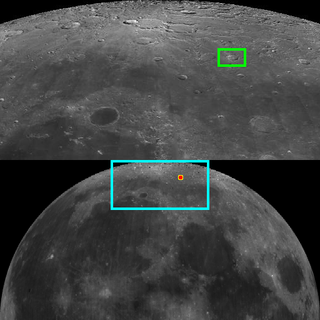
C. Mayer is a lunar impact crater that is located at the northern edge of the Mare Frigoris, due north of the prominent crater Aristoteles. Also to the south, but only a third as distant, is the smaller crater Sheepshanks. Due east of C. Mayer is the flooded crater Kane.
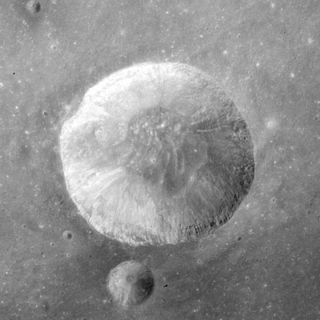
Carmichael is a lunar impact crater that is located along the eastern edge of the Sinus Amoris, in the northeastern quadrant of the Moon's near side. Its diameter is 20 km. It was named after American psychologist Leonard Carmichael. It lies within a couple of crater diameters south-southwest of the smaller crater Hill. Further to the east-northeast is the prominent crater Macrobius. Carmichael was designated Macrobius A before being given its current name by the IAU.

Drude is a lunar impact crater that lies on the far side of the Moon, in the rugged Montes Cordillera range that forms the outer ring around the Mare Orientale impact basin. It is located just behind the west-southwest limb, and this area is sometimes brought into sight from Earth during favorable librations. However, even at such times, the crater is viewed from the edge and little detail can be seen.

Gardner is a small lunar impact crater in the northeast part of the Moon. It was named after an American physicist Irvine Clifton Gardner in 1976. It lies due east of the crater Vitruvius, in a section of rough terrain north of the Mare Tranquillitatis. Gardner was previously designated Vitruvius A before being given its present name by the IAU. To the northeast of Gardner is the larger crater Maraldi.

Feuillée is a small lunar impact crater in the eastern part of the Mare Imbrium. It was named after French natural scientist Louis Feuillée. It lies less than a half crater diameter to the northwest of Beer, and the two formations form a nearly matched pair. To the west is the small but prominent crater Timocharis.
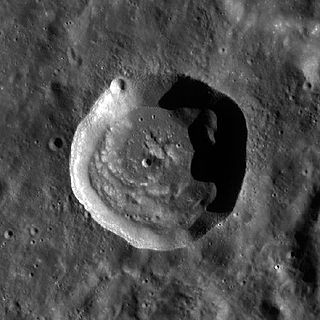
Chant is a lunar impact crater that is located on the far side of the Moon, behind the southwest limb as seen from the Earth. It lies within the southwestern part of the blanket of ejecta surrounding the Mare Orientale, beyond the Montes Cordillera mountain ring. To the west-northwest is the large walled plain Blackett. Southward is the crater Mendel.

Foucault is a small lunar impact crater that lies along the southern edge of Mare Frigoris, to the southeast of the crater Harpalus. In the rugged terrain to the south of Foucault is Sharp. The outer perimeter of Foucault forms a somewhat irregular circle, with slight outward bulges to the south and northeast. The inner wall of the rim is not notably terraced, and slopes down directly to the uneven floor. It is named after physicist Léon Foucault, most famous for the Foucault pendulum.

Chalonge is a lunar impact crater that is located on the far side of the Moon. It lies to the southwest of the larger crater Lewis, in the outer skirt of ejecta that surrounds the Mare Orientale impact basin. To the southeast are the Montes Cordillera, a ring of mountains that encircle the Mare Orientale formation.
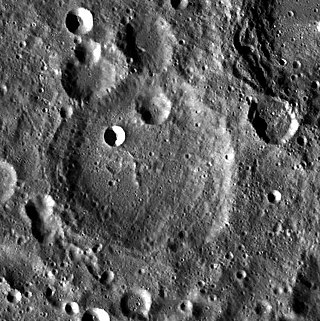
Kurchatov is a lunar impact crater that is located on the Moon's far side. It is just to the southwest of the crater Wiener, and farther to the southeast of Bridgman. A couple of crater diameters to the south of Kurchatov is the northern edge of the Mare Moscoviense.























